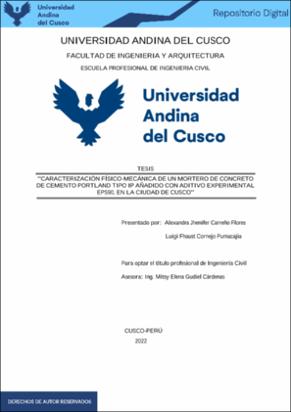| dc.contributor.advisor | Gudiel Cárdenas, Mitsy Elena | |
| dc.contributor.author | Carreño Flores, Alexandra Jhenifer | |
| dc.contributor.author | Cornejo Pumacajia, Luigi Fhaust | |
| dc.date.accessioned | 2023-01-04T13:47:25Z | |
| dc.date.available | 2023-01-04T13:47:25Z | |
| dc.date.issued | 2022-11-11 | |
| dc.identifier.uri | https://hdl.handle.net/20.500.12557/5131 | |
| dc.description.abstract | La investigación denominada:” Caracterización físico-mecánica de un mortero de
concreto de cemento portland tipo IP añadido con aditivo experimental EPS90, en la ciudad
de cusco”, consiste en la adición del aditivo experimental a la mezcla de mortero en 3%,5% y
7% del peso de cemento, así mismo se realizó muestras sin aditivo experimental EPS90. El
primer ensayo que se realizó para el mortero en estado endurecido fue el de resistencia a
compresión, este ensayo se realizó de acuerdo a la NTP 334.051, en el cual las muestras de
cubos de mortero de 50mm de lado son sometidas a una fuerza a compresión. La resistencia a
compresión del mortero modificado al 3% nos dio mayor resistencia que el resto de
porcentajes. El segundo ensayo que se realizo fue de adherencia a cizalle, este ensayo se
realizó según la norma chilena (NCh)167, para el caso del mortero modificado al 3%
realizado a los 28 días de edad, nos dio un resistencia superior del resto de porcentajes, cabe
resaltar que este ensayo se realizó para 14, 21 y 28 días de edad, observando que para el caso
del mortero modificado al 7% a los 14 días de edad, se duplico la adherencia respecto el resto
de porcentajes y además se observó que mientras aumenta la edad esta adherencia se
mantiene casi constante para este porcentaje. El tercer ensayo que se realizó, fue el de fluidez
de mortero, este ensayo se realizó tanto para medir la fluidez de cubos de mortero y
adherencia a cizalle, dándonos una mayor fluidez al 3% para ambos casos, siendo este
mortero más trabajable que el resto de porcentajes. El cuarto ensayo que se realizo fue el de
tiempo de fraguado, este ensayo se realizó para 3 rangos de temperaturas, siendo estas
temperaturas altas, medias y bajas, el tiempo de fraguado que tienen las muestras modificadas
aumenta mientras más aditivo experimental EPS90 contenga, también este varía de acuerdo a
la temperatura que fue realizado, para el caso de temperaturas bajas nos dio mayor tiempo de
fraguado que el resto de temperaturas. | es_PE |
| dc.description.abstract | The research called: "Physical-mechanical characterization of a Portland cement
concrete mortar type IP added with experimental additive EPS90, in the city of Cusco",
consists of the addition of the experimental additive to the mortar mixture at 3%, 5% and 7%
of the weight of cement, likewise samples were made without experimental additive EPS90.
The first test that was carried out for the mortar in the hardened state was that of compressive
strength, this test was carried out in accordance with NTP 334.051, in which the samples of
mortar cubes with 50mm sides are subjected to a compressive force. The compressive
strength of the 3% modified mortar gave us greater strength than the rest of the percentages.
The second test that was carried out was shear adhesion, this test was carried out according to
the Chilean standard (NCh)167, in the case of the 3% modified mortar carried out at 28 days
of age, it gave us a higher resistance than the rest of the percentages, it should be noted that
this test was carried out for 14, 21 and 28 days of age, noting that in the case of the 7%
modified mortar at 14 days of age, adherence doubled with respect to the rest of the
percentages and it was also observed that as age increases, this adherence remains almost
constant for this percentage. The third test that was carried out was that of mortar fluidity, this
test was carried out both to measure the fluidity of mortar cubes and shear adhesion, giving us
a greater fluidity at 3% for both cases, this mortar being more workable than the rest of the
percentages. The fourth test that was carried out was the setting time, this test was carried out
for 3 temperature ranges, these being high, medium and low temperatures, the setting time of
the modified samples increases the more experimental EPS90 additive it contains, also this
varies according to the temperature at which it was made, in the case of low temperatures it
gave us a longer setting time than the rest of the temperatures. | en_US |
| dc.format | application/pdf | es_PE |
| dc.language.iso | spa | es_PE |
| dc.publisher | Universidad Andina del Cusco | es_PE |
| dc.rights | info:eu-repo/semantics/openAccess | es_PE |
| dc.rights.uri | https://creativecommons.org/licenses/by-nc-nd/4.0/ | es_PE |
| dc.subject | Aditivo experimental | es_PE |
| dc.subject | Resistencia a la compresión | es_PE |
| dc.subject | Tiempo de fraguado | es_PE |
| dc.subject | Mortero | es_PE |
| dc.title | Caracterización físico-mecánica de un mortero de concreto de cemento portland tipo IP añadido con aditivo experimental EPS90, en la ciudad de Cusco | es_PE |
| dc.type | info:eu-repo/semantics/bachelorThesis | es_PE |
| thesis.degree.name | Ingeniero Civil | es_PE |
| thesis.degree.grantor | Universidad Andina del Cusco. Facultad de Ingeniería y Arquitectura | es_PE |
| thesis.degree.discipline | Ingeniería Civil | es_PE |
| dc.publisher.country | PE | es_PE |
| dc.subject.ocde | https://purl.org/pe-repo/ocde/ford#2.01.00 | es_PE |
| renati.advisor.dni | 23950550 | |
| renati.advisor.orcid | https://orcid.org/0000-0003-1472-6809 | es_PE |
| renati.author.dni | 73883842 | |
| renati.author.dni | 72481432 | |
| renati.discipline | 732016 | es_PE |
| renati.juror | Pezo Zegarra, Eliot | |
| renati.juror | Roman Villegas, Eigner | |
| renati.juror | Humberto Cabezas, José | |
| renati.juror | Bellota Limachi, Cristel Arascelly | |
| renati.level | https://purl.org/pe-repo/renati/level#tituloProfesional | es_PE |
| renati.type | https://purl.org/pe-repo/renati/type#tesis | es_PE |


